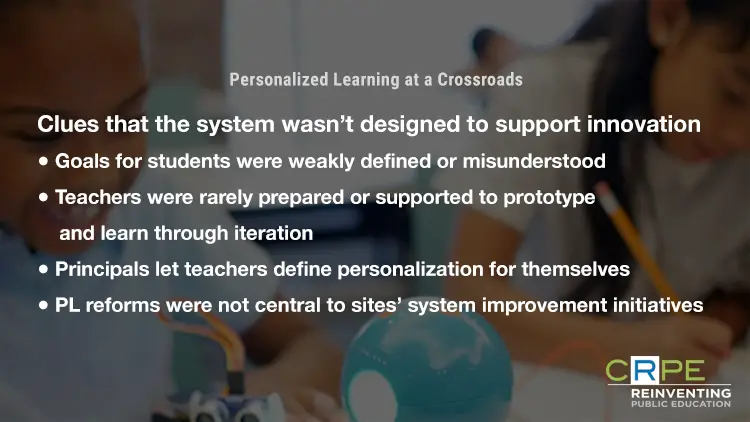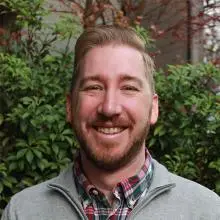Samantha Olson is the Vice President of Strategy for the Colorado Education Initiative (CEI), which supports districts and schools in personalized learning and systems change. CEI was part of the Regional Funds for Breakthrough Schools initiative, the subject of a recent CRPE report. Olson spoke to CRPE’s Sean Gill about CEI’s work.
Gill: CEI held its 2018 Showcase in June. What was the meeting about? What did CEI hope to accomplish at the meeting?
Olson: The Showcase is an annual convening designed to highlight the innovative work of schools and districts across Colorado. We want to create new connections across our statewide network to ignite interest and explore what’s possible. It’s been likened to a “summer camp” for educators.
In the past year, CEI’s strategy has changed in ways that align pretty heavily with the findings of CRPE’s recent report on personalized learning. We recognized the need to be focused on district transformation, such that systems are designed to be increasingly responsive to evolving needs of their students and communities. In the past, more of our work was partnering with individual schools. While our supports for improvement and innovation will always be rooted in change at the school level, we think we can be particularly helpful in supporting those districts that really want to shift how they operate in support of sustaining and diffusing this work. All of the district teams that came to the Showcase were working with us on some aspect of system change, largely with focuses on high school redesign, competency-based and personalized learning, or next-generation learning. We had about 20 districts with pretty strong statewide representation.
We asked people to work a little harder than they had previously. We really wanted to use this opportunity as time for them to plan for the year ahead.
Gill: At the Showcase, CRPE’s Michael DeArmond and Betheny Gross presented our research on several major initiatives to develop personalized learning. What are the most important takeaways for state and district leaders to consider?
Olson: Existing systems were not designed for innovation—that finding really resonated with both the supports CEI offers and the experiences of some of our district partners who are most advanced in their system learning. School systems need to build a new culture of prototyping and learning: school leadership has to develop new kinds of support for teachers to do this work and to manage change. Promoting alignment has to be a key focus of the central office.
Stepping back, we’re three years in on a ten-year journey. To me, CRPE’s report was formative information to remind us why we started the work and think about whether we are on track for transformative change. Just because a grant ended, that doesn’t mean the work ended. The report reminds us that we want system change and we’re still on that journey. But there are some real things that could be done if we were serious about driving this from 1 percent of students to 100 percent of students, a goal of this work.
Gill: What are some other tools from the Showcase that could be helpful for schools and districts engaged in similar work?
Olson: Many of the resources are on CEI’s website. Our innovation specialist Paul Beck led a good presentation on goal setting. School Retool and San Juan BOCES led a session on prototyping, there is also worksheet. The idea behind this was helping people think about how to bring together principles of improvement science and user-centeredness. We also had presentations from Colorado Springs School District 11, Mesa County Valley School District 5, and Thompson School District. They have all taken a really deliberate systems approach to scaling their personalized learning work.
Gill: Do you think there’s anything unique about Colorado that allowed you and your partners to tackle personalized learning in a different way than schools and districts in other places?
Olson: When we began our work, the state Department of Education was at the table, as were three districts. This might set us apart from some other regional funds. Our five organizations cocreated our approach to the work. All of the partners around the table felt like we knew that we were reaching for a broader vision of student outcomes. We thought personalized learning was a critical lever to get there, and that we meant for this work to transform systems, not to be like a pilot program.
There was also a really critical opportunity in the Colorado state policy landscape. Colorado’s Graduation Guidelines are supportive of and encouraging of the broader view of student outcomes. They opened up the door for districts to allow students to demonstrate competency through performance demonstrations and portfolios. This policy also promotes the idea of multiple pathways and supports the idea of competency-based progression. It offers an important lever for participating teachers to see how their work is aligned with, versus disconnected from, state expectations.
Gill: For readers who aren’t familiar, can you explain more about your organization’s role in Colorado’s education system? You’re neither a district nor part of the state department of education. What can you do that those entities can’t do on their own?
Olson: Our role of convening meaningful networks statewide is something that districts cannot do on their own and the department alone isn’t really positioned to do beyond state programs on these topics. We have the ability to make connections between disparate parts of the state or even geographically continuous districts that may lack natural structures for meaningful learning from or collaborating with one another. Our partners indicate that they appreciate having CEI as an intermediary state-level organization to bring them together, create the time and space for them to network across schools and districts, and then have that space to engage and plan and design as a team. We broker many different organizations that provide technical assistance to help ensure Colorado schools and districts have access to high-quality and cutting-edge resources and supports.
Ideally, we can also help districts tell their stories. We want to spotlight to the community that this is important and innovative work. An organization like CEI can help to lift up the voices of the most innovative educators doing this work. As a third party, we can facilitate connections between research, policy, and practice on the ground and share them at the state level by inviting other stakeholders into the conversation. Not a lot of organizations are positioned in the same way.
Gill: Are schools and districts implicitly attracted to the mindset required for system change or do you have to help get them there? Do they trust you?
Olson: I think that because we have a statewide network and a real understanding of the local context in the places we work, we have built trust. Our philosophy is that we don’t come in with a set answer, but really as a partner. That’s our reputation.
When we began this work, it was a different time. Five years ago, we partnered with the state education agency, Coloradoans, educators, industry leaders, and economists to develop the vision of the “Running Kid”—a broader vision of student outcomes, including both academic and non-academic outcomes essential for 21st century success. I have heard many district leaders say, “We know we measure what we value, and we value what we measure—we only measure academics.” Now, broader outcomes are more universally emphasized. Over the next five years, we’re looking to partner with others to help bring clarity and support for how we bring rigor and credibility to the development of measures that relate to social, emotional, and other non-academic skills, and how advances in neuroscience and the science of learning can impact learning and school design.
Gill: Do you support districts in explaining to the general public what personalized learning or system transformation is?
Olson: We do. Something we’re trying to figure out is, if this work really shouldn’t be done and can’t be done well without different forms of community engagement, what are these different models? If the goal is really a new voice—as in new roles for and empowerment of students, families, and communities, what kind of support do schools and districts need to facilitate this kind of meaningful engagement? We are learning alongside our school and district partners what this can look like.
We hope to be leaning more into that storytelling and movement building. Colorado saw a number of successful local, voter-approved taxes this year. When districts are engaging in their local efforts, we want there to be a broader narrative that supports their local efforts.
Gill: What’s your priority at CEI for this upcoming school year? What kind of work will you continue to do?
Olson: I mentioned figuring out how to be smart about bringing measurements to the work as a priority for this year. Similarly, if the work is about system change, what are indicators of system readiness and system change? Earlier this year, our CEO and senior partner authored a series of whitepapers around accountability. While we have policies that allow us to do personalized learning today, long term, our accountability system must be designed to promote and measure this kind of work and incentivize rigorous continuous improvement.
Additionally, we’re asking, How do we support schools and districts to place equity at the center of their redesign effort? In some places, we see this work progressing with equity at the center, and in other places we don’t. Many of the schools and districts around Colorado are facing rapid demographic shifts and know they need to be prepared to work differently to capitalize on the assets of their students and communities. We want to be a partner who can help them think about how they are best supporting their students and communities.






